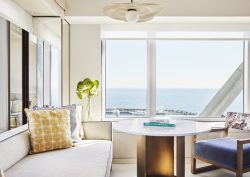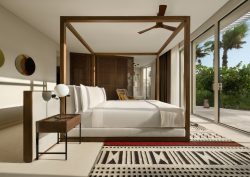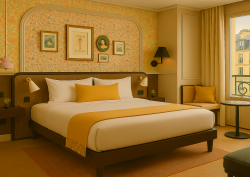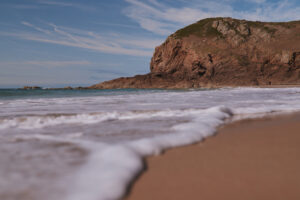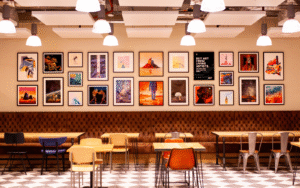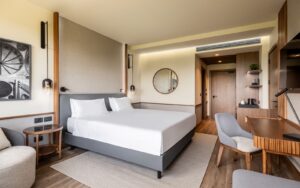Meeting in London’s leafy Richmond Park ahead of 60-mile bike ride around the Surrey Hills, Editor Hamish Kilburn and Dale Atkinson, Founder, Rosendale Design discuss blurring boundaries in hospitality, the new meaning of wellness and the value of relationships in interior design…
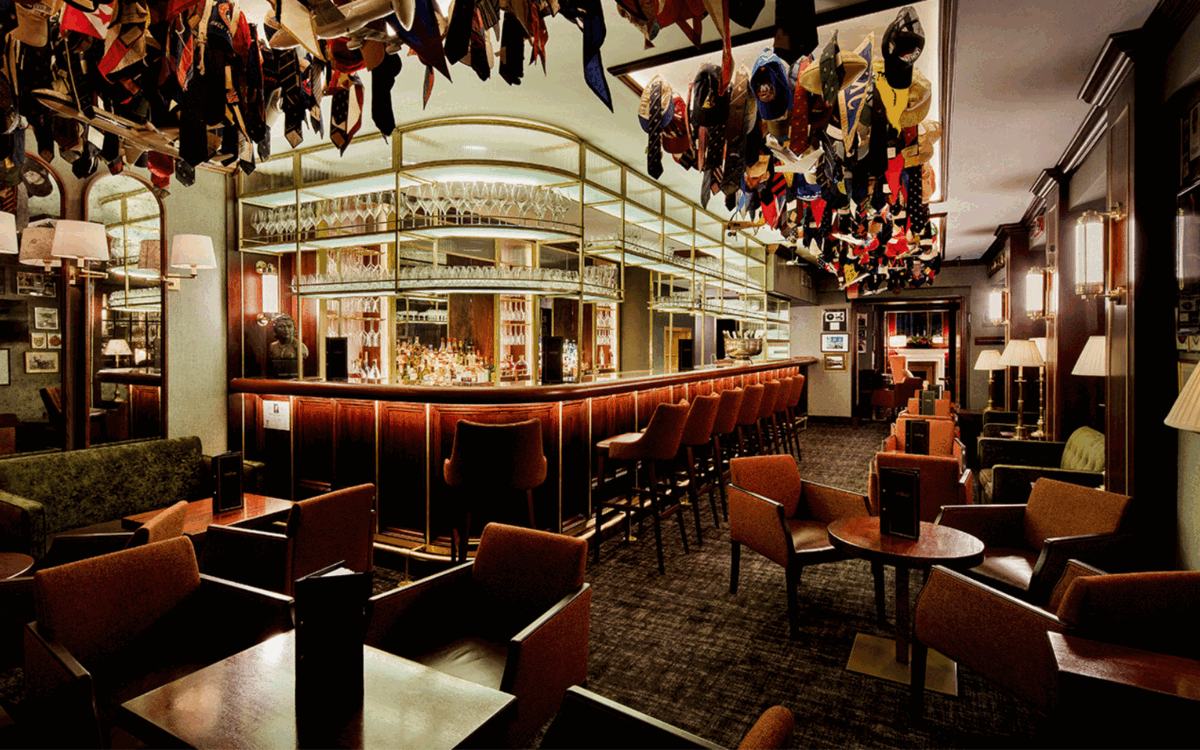
Holding a dictaphone while trying to maintain an aerodynamic position while on a road bike is a first for me. But when interior designer Dale Atkinson, Founder of Rosendale Design, and I both discovered cycling as a common ground/hobby, when we caught up recently at MEET UP London, it was only ever going to be a matter of time before we would both find ourselves in the saddle and fighting for slipstreams while confronting epic climbs.
That glorious day came sooner than I thought. As April creeped into May – on a balmy spring morning, I arrived in Atkinson’s hometown of Richmond with the ambitious aim to conduct an engaging interview on two wheels. “I love exploring this area. Despite the fact that I live here, I am always taken aback by how much there is to be inspired by,” Atkinson said warmly as we clipped in to start our 60-mile adventure. “Seriously, it has it all. The architecture of old stately homes, such as Ham House – and Petersham Nurseries is on our door step. The blossoming Isabella Plantation, with its vibrant colours! And Kew Gardens is just around the corner. [As a designer], I can find inspiration everywhere I turn.”

Image caption: In 2014, Dale Atkinson founded Rosendale Design. Since then, the interior designer has worked on many hospitality and residential projects that eloquently and meaningfully challenge conventional approaches to design. | Image credit: Rosendale Design
Aware that interviewing Atkinson on busy roads while cycling would be a unwise idea – even by my standards – I challenged myself to get the full low-down from the interior designer – from his time at Foster + Partners and other studios to now nurturing his very own success story of a studio – in the time it took us to complete our warm-up laps around Richmond Park, which if you didn’t know is a cycling haven where the traffic obstructions largely consist of wild deer and other cyclists. And there was no better place to start our interview than in the present moment. As we made our way past Richmond Gate, I wanted to learn more about Atkinson’s most recent project.
Hamish Kilburn: Having seen some of the photos of your work at Hamptworth Golf Club, how and why is it becoming acceptable to blur the boundaries in design between hotels, members clubs and even residential?
Dale Atkinson: I think nowadays, it is not acceptable, but necessary, for country clubs, members clubs and hotels to be able to offer as many amenities as possible to retain the customers within the property and extend their time, and thus spending.
-

- Image caption: Render of the new arrival experience at Hamptworth Golf Club. | Image credit: Rosendale Design
-

- Image caption: Render of the new F&B experience at Hamptworth Golf Club. | Image credit: Rosendale Design
Members clubs have for some time provided their members with spaces to work and have meetings from, but they also provide great socialising facilities and in some cases rooms to stay overnight. But not everyone has access, or can afford, to join these clubs. Now, many establishments, including hotels, want to follow suit and provide these facilities with a similar ambiance.
With many working from home, the pandemic really kick-started an onslaught of home improvements, and many wanted to recreate environments where they can escape.
“Each project gives me a new lease of energy.” – Dale Atkinson, Founder, Rosendale Design.
HK: Honestly, what’s been the highs (climbs) and the lows (descents) since setting up your own studio in 2014?
DA: Undoubtedly, the pandemic would take top spot for the low point, as it would for many! But I must confess, in retrospect, it also gave me the opportunity to learn how to be more malleable as a company. We really did have to carefully navigate issues daily.
The high point, to be truthful, happens with every new project! Each project gives me a new lease of energy. For me, it is all about the people and I love working closely with, especially our clients, and getting to know them as people. Right now, we are again working with Badrutts Palace, in St Moritz, and they are such an amazing team to work with. It is an honour to know we pleased them so much with our first collaboration just before the pandemic. Most of our clients are returning and some recommend us to friends and family. For me, the personal aspect is always far more fulfilling, it is why I do what I do!
HK: Considering where we are and what we’re doing (speeding down Broomfield Hill at pace), it would be remise of me not to bring up wellness. In your eyes, how has this mega trend taken on a whole new meaning since 2020?
DA: Well, I think there has always been a focus on physical wellness or mental wellbeing but in the last couple of years a wholistic approach has really come to the fore. This has also reinforced our connection with nature, which is also driving sustainability. Those buzzwords get mentioned a lot, but they are all so tightly interwoven.
With most of us experiencing 2020 in the confines of our houses, the first lockdown in particular was a real shock to the system, and mental wellbeing was highlighted.
HK: Your portfolio is glued together by the solid relationships you form with your clients. Just how important is that element of your business?
DA: I really love what I do, and I consider myself very fortunate, but this is solely because of the amazing people you meet along the way.
I keep in contact with many clients long after the project completes. For example, I have known Michelin-star chef and restauranteur Jason Atherton and his family for 10 years. This decade-long relationship developed into an understanding and, ultimately, a trust that he bestowed onto me when he asked me to design his family home.

Image caption: One of Dale Atkinson’s passion projects, among many, has been designing the CEO of Burberry’s house. | Image credit: Rosendale Design
HK: What’s been the biggest lesson you have learned since starting your own business – and knowing what you know now in this industry, would you do anything differently if you could turn back the clock?
DA: The biggest lesson I have learned is the value of relationships, not only with clients, but the building team and even design team. If everyone is onboard working together and enjoying themselves then you get to the end and feel so much better. I hear stories of some people who believe taking a hardline keeps people on their toes and increases productivity, but I don’t see it. I’m far more willing to go above and beyond for someone I respect – I think it is human nature.
The other lesson I learned, and is just as important, is to believe in yourself and your instincts. Listen to the small voice inside – its there for a reason. Also, there are times you really need to sell an idea to a client that you believe in. If they see your belief and determination then nine times out of 10, the client will trust you. Once they sense a lack of belief, it can all unravel.
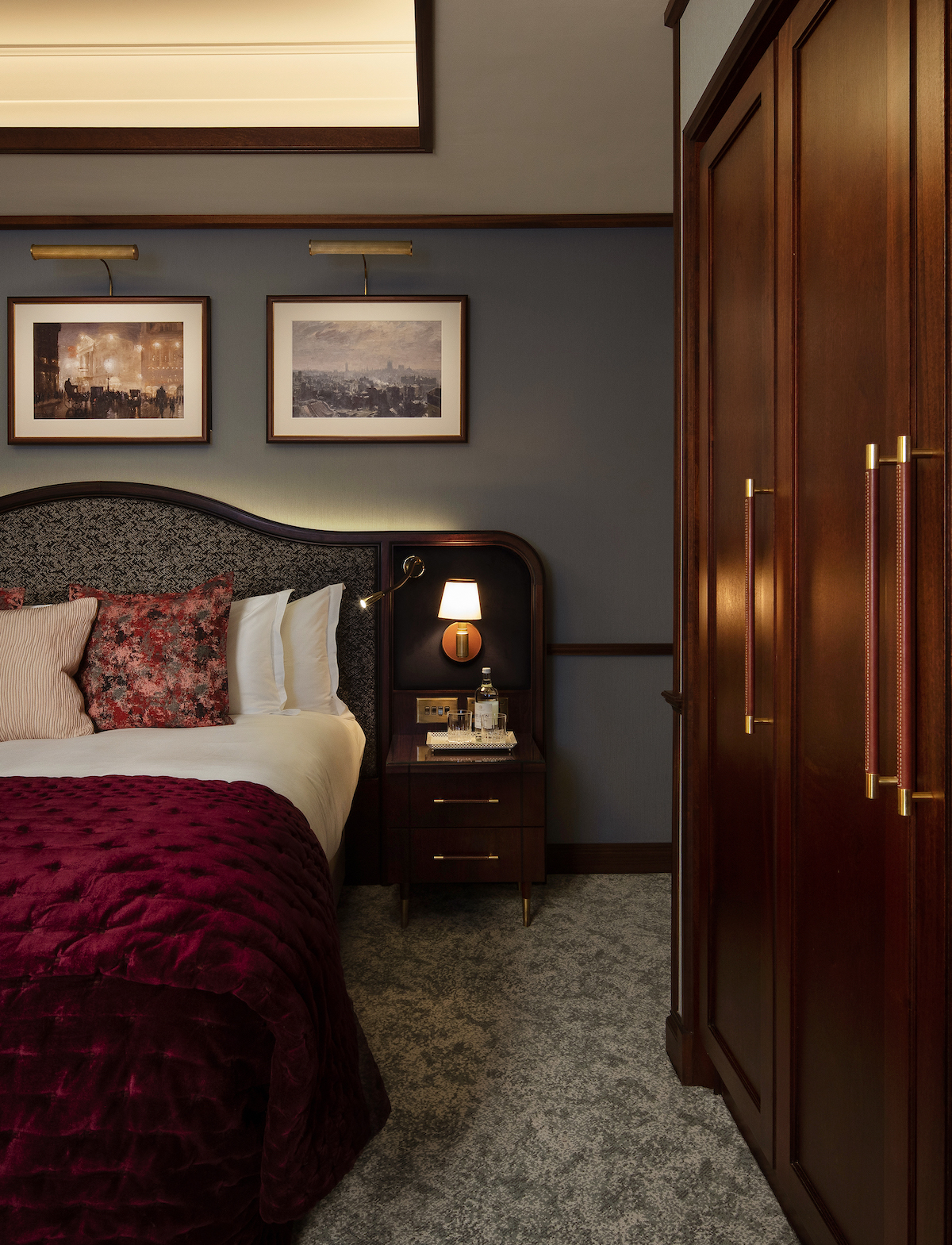
Image caption: The guestrooms inside The Stafford Hotel were designed by Dale Atkinson and his team, following the studio’s sucess
DA: One thing I learned about you recently was that you were a lighting designer before becoming an ‘interior designer’. What’s the biggest pitfall designers can fall down when they don’t have the budget for a lighting consultant?
DA: It was always my intention to study the properties of light before setting up on my own. I worked at a lighting design consultancy for a couple years until I was asked to join the team at Foster + Partners.
I do feel that there are many that do not fully understand the properties of light, which is, put simply, one of the most important mediums we work with. When I was studying at the Bartlett, I focussed on this.
In general, lighting designers can help bring a space to life by creating layers within the scheme, considering both artificial and natural light. I feel this sets Rosendale Design aside from the others, as we can provide tailored concepts but the client does not need to hire a lighting designer, and can save a considerable amount.
Following my quick-fire catch-up with Atkinson, it was time to put down the microphone and safely head out towards the countryside, where the climbs were real, to practice what we preached when it came to wellness.

Image caption: Multitasking, Editor Hamish Kilburn and interior designer Dale Atkinson wrapped up the interview and headed out for an inspirational cycle, which took them on an adventure around the Surrey Hills to return to Richmond Park where they soaked up the colourful display inside Isabella Plantation. There are worse ways to spend a Friday.
For me, it was beyond refreshing to speak to an interior designer in their own territory, while doing what we both loved. By taking a bit of risk – I mean, I could have ended up on somebody’s windscreen in the making of this memorable interview and experience – stepping away from my desk and the emails to seek inspiration in nature, I have realised that relationships in this arena can indeed be fuelled by pedal power, banter and a cheeky mid-ride glass of fizz. After all, it’s not all work and no play.
Main image credit: Rosendale Design





